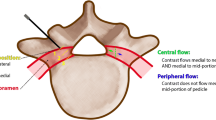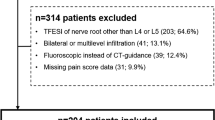Abstract
Purpose
To evaluate the effect of needle position on the laterality of contrast flow in CT-guided lumbar interlaminar epidural steroid injections.
Materials and methods
A retrospective review of consecutive CT-guided interlaminar lumbar epidural steroid injections was performed. The terminal needle tip position (midline or lateral) and the laterality of epidural contrast were evaluated by two readers. Contrast flow pattern was classified as ipsilateral to needle trajectory, bilateral, or contralateral. Bilateral flow was further divided into asymmetric, symmetrical, or asymmetric to the contralateral side. Inter-reader agreement was calculated with the kappa statistic. The relationship of needle position to contrast laterality was calculated with the chi statistic. Pain scores were compared for bilateral and unilateral flows with a two-tailed T test for independent means.
Results
A total of 250 injections were included in 204 patients, with an age range of 24 to 93 years. The most commonly injected level (145/250) was L4–L5. Agreement between the two readers was almost perfect and substantial (kappa 0.751–0.880). The majority of injections (154/250) demonstrated contrast flow ipsilateral to the needle trajectory, 90/250 demonstrated bilateral flow, and 6/250 had contralateral flow. Of the 90 cases with bilateral flow, 80% were performed with a midline terminal needle position (p < 0.001). There was no difference in immediate post-procedure pain scores between patients with ipsilateral or bilateral contrast flow.
Conclusion
For interlaminar epidural steroid injections, a midline terminal needle tip position has a greater probability of producing bilateral contrast flow compared to a lateral terminal needle tip position.


Similar content being viewed by others
References
Boswell MV, Hansen HC, Trescot AM, Hirsch JA. Epidural steroids in the management of chronic spinal pain and radiculopathy. Pain Physician. 2003;6(3):319–34.
Bise S, Langlet B, Pesquer L, Poussange N, Silvestre A, Dallaudiere B. Transforaminal versus interlaminar CT-guided lumbar epidural steroid injections: prospective study of 237 patients with unilateral radicular pain and up to 5 years of follow-up. Skeletal Radiol [Internet]. 2023. https://doi.org/10.1007/s00256-023-04290-y
Gupta R, Singh S, Kaur S, Singh K, Aujla K. Correlation between epidurographic contrast flow patterns and clinical effectiveness in chronic lumbar discogenic radicular pain treated with epidural steroid injections via different approaches. Korean J Pain. 2014;27(4):353–9.
Wang M, Ling H, Zheng B, Song L. Predictors of a favorable response to transforaminal epidural steroid injections for lumbar radiculopathy in the elderly. Pain Physician. 2023;26(4):347–55.
Ackerman WE, Ahmad M. The efficacy of lumbar epidural steroid injections in patients with lumbar disc herniations. Anesth Analg. 2007;104(5):1217–22 (tables of contents).
Manchikanti L. Transforaminal lumbar epidural steroid injections. Pain Physician. 2000;3(4):374–98.
Manchikanti L, Staats PS, Singh V, Schultz DM, Vilims BD, Jasper JF, et al. Evidence-based practice guidelines for interventional techniques in the management of chronic spinal pain. Pain Physician. 2003;6(1):3–81.
Mandell JC, Czuczman GJ, Gaviola GC, Ghazikhanian V, Cho CH. The lumbar neural foramen and transforaminal epidural steroid injections: an anatomic review with key safety considerations in planning the percutaneous approach. Am J Roentgenol. 2017;209(1):W26-35.
Whitlock EL, Bridwell KH, Gilula LA. Influence of needle tip position on injectate spread in 406 interlaminar lumbar epidural steroid injections. Radiology [Internet]. 2007;243(3):804–11.
Amrhein TJ, Bozdogan E, Vekaria S, Patel P, Lerebours R, Luo S, et al. Cross-sectional CT assessment of the extent of injectate spread at CT fluoroscopy-guided cervical epidural interlaminar steroid injections. Radiology. 2019;292(3):723–9.
Landis JR, Koch GG. The measurement of observer agreement for categorical data. Biometrics [Internet]. 1977;33(1):159–74.
Lee B, Lee SE, Kim YH, Park JH, Lee KH, Kang E, et al. Evaluation of contrast flow patterns with cervical interlaminar epidural injection: comparison of midline and paramedian approaches. Med. 2021;57(1):1–10.
Conger A, Sperry BP, Cheney CW, Kuo K, Petersen R, Randall D, et al. Does the contrast dispersion pattern during fluoroscopically guided cervical transforaminal epidural steroid injection predict short-term pain and functional outcomes? An exploratory analysis of prospective cohort data. Pain Med (United States). 2020;21(12):3350–9.
Savolaine ER, Pandya JB, Greenblatt SH, Conover SR. Anatomy of the human lumbar epidural space: new insights using CT-epidurography. Anesthesiology [Internet]. 1988;68(2):217–20.
Nada EMS, Turan MA, Mohamed MN. Some epidurographic explanations for incomplete epidural analgesia coverage in the absence of a catheter. J Clin Anesth [Internet]. 2013;25(7):565–71.
Guner D, Asik I, Ozgencil GE, Peker E, Erden MI. The correlation of epidural fibrosis with epiduroscopic and radiologic imaging for chronic pain after back surgery. Pain Physician. 2021;24(8):E1219–26.
Furman MB, Lee TS, Mehta A, Simon JI, Cano WG. Contrast flow selectivity during transforaminal lumbosacral epidural steroid injections. Pain Physician. 2008;11(6):855–61.
Makkar JK, Singh NP, Rastogi R. Volume of contrast and selectivity for lumbar transforaminal epidural steroid injection. Pain Physician. 2015;18(1):101–5.
Castro WH, Grönemeyer D, Jerosch J, Seibel R, Lorenz G, Beutelstahl D, et al. How reliable is lumbar nerve root sheath infiltration? Eur Spine J [Internet]. 1994;3(5):255–7.
Author information
Authors and Affiliations
Corresponding author
Ethics declarations
Conflict of interest
The authors declare no competing interests.
Additional information
Publisher's Note
Springer Nature remains neutral with regard to jurisdictional claims in published maps and institutional affiliations.
Rights and permissions
Springer Nature or its licensor (e.g. a society or other partner) holds exclusive rights to this article under a publishing agreement with the author(s) or other rightsholder(s); author self-archiving of the accepted manuscript version of this article is solely governed by the terms of such publishing agreement and applicable law.
About this article
Cite this article
Mojarrad, M., Wieschhoff, G.G. & Mandell, J.C. Contrast flow in CT-guided lumbar interlaminar epidural steroid injections: does needle position effect the laterality of contrast flow?. Skeletal Radiol 53, 1313–1318 (2024). https://doi.org/10.1007/s00256-024-04588-5
Received:
Revised:
Accepted:
Published:
Issue Date:
DOI: https://doi.org/10.1007/s00256-024-04588-5




